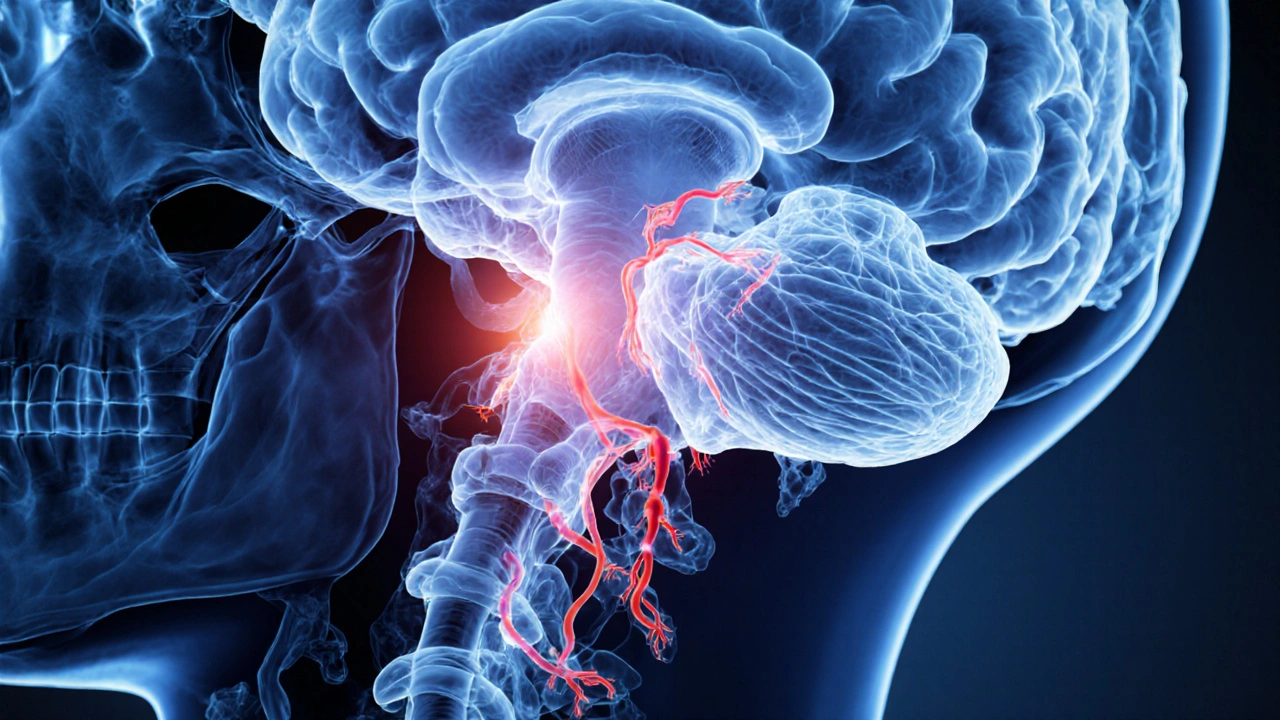Vomiting Cause Identifier
Potential Cause Identified
Ever wondered why your stomach suddenly decides to eject its contents? That abrupt, uncomfortable feeling isn’t random - it’s a well‑orchestrated signal from your brain and gut. Below we break down the biology, the most common triggers, and practical steps you can take to keep the gag reflex in check.
How the Body Triggers Vomiting
Vomiting is the forceful expulsion of stomach contents through the mouth, driven by a reflex arc that starts in the brainstem. The brain region responsible is called the vomiting center (a collection of nuclei in the medulla, including the area postrema, that integrates signals and initiates the motor pattern. When this center receives a "danger" signal, it tells the diaphragm, abdominal muscles, and esophagus to contract in a coordinated burst, expelling food, liquid, and gastric secretions.
The vomiting reflex can be activated by four main pathways:
- Direct irritation of the stomach lining (e.g., toxins, bacterial overgrowth).
- Signals from the inner ear’s vestibular system (detects motion and balance, sending input to the brainstem that can trigger motion sickness.
- Chemical triggers in the blood that reach the area postrema (a chemoreceptor zone lacking a blood‑brain barrier.
- Higher‑order brain inputs (stress, anxiety, sight or smell of spoiled food).
Understanding which pathway is at work helps you choose the right preventive strategy.
Main Triggers That Set Off the Vomiting Reflex
Vomiting isn’t a disease; it’s a symptom. Here are the most frequent culprits and how they act:
| Cause | Typical Signs | Prevention Tips |
|---|---|---|
| Gastroenteritis (viral or bacterial inflammation of the stomach and intestines | Watery diarrhea, stomach cramps, low‑grade fever | Stay hydrated, avoid raw foods, practice hand hygiene |
| Food poisoning (toxin‑producing bacteria like Salmonella or E. coli | Sudden nausea, vomiting, abdominal pain within hours | Cook meats thoroughly, refrigerate leftovers quickly |
| Motion sickness (conflicting signals between inner ear and visual input | Dizziness, cold sweats, nausea after travel | Sit in the front seat, focus on the horizon, use ginger or over‑the‑counter antihistamines |
| Morning sickness (pregnancy‑related nausea, peaking in the first trimester | Frequent nausea, occasional vomiting, worse after meals | Eat small, bland snacks, stay hydrated, consider vitamin B6 supplements |
| Chemotherapy‑induced nausea (toxic agents damage the gut lining and trigger the chemoreceptor trigger zone | Persistent nausea before, during, or after treatment | Prescription antiemetics (e.g., ondansetron), eat cold foods, avoid strong odors |
| Alcohol intoxication (irritates gastric mucosa and disrupts CNS control | Stomach burn, dizziness, vomiting after heavy drinking | Drink water between drinks, avoid binge drinking, eat before alcohol |
Even though the list feels long, most episodes fall into one of these buckets. Pinpointing the root cause trims down trial‑and‑error.

When Vomiting Signals a Serious Issue
Not all vomiting is harmless. Red flags that merit urgent medical attention include:
- Blood in the vomit (bright red or coffee‑ground appearance).
- Persistent vomiting for more than 24hours, especially in children or the elderly.
- Severe abdominal pain, rigidity, or a high fever (>38.5°C).
- Signs of dehydration: dry mouth, dizziness, low urine output.
- Neurological symptoms: confusion, severe headache, vision changes.
If you notice any of these, seek professional care right away. Early intervention can prevent complications such as electrolyte imbalance or aspiration pneumonia.
Practical Ways to Stop an Upcoming Vomit
When you feel the queasy rumble, these steps often calm the reflex before it escalates:
- Change your posture. Sit upright or lie on your side. Lying flat can worsen nausea by increasing pressure on the stomach.
- Control your breathing. Inhale slowly through the nose for four counts, hold for two, exhale through the mouth for six. Deep breathing reduces the sympathetic “fight‑or‑flight” signal that fuels nausea.
- Cool the back of your throat. Suck on an ice chip or sip cold water. The cold sensation can deactivate the gag nucleus.
- Ginger or peppermint. Chew a small piece of fresh ginger or sip peppermint tea. Both have been shown in clinical studies to reduce nausea by modulating gastric motility.
- Avoid strong smells. Open a window, turn off cooking odors, and stay away from perfume.
- Use over‑the‑counter antiemetics. Dimenhydrinate (Dramamine) or meclizine work well for motion‑related nausea. Follow the label dosage.
Remember, the goal isn’t to suppress a healthy protective mechanism forever-just to give your body a moment to settle.

When to Seek Medical Help
If self‑care doesn’t bring relief within a few hours, or if any red‑flag symptom appears, contact a health professional. For pregnant individuals, call your obstetrician; for children, a pediatrician. In cases of suspected toxin ingestion or severe dehydration, call emergency services.
Quick Takeaways
- Vomiting is a brain‑stem reflex that protects you from harmful substances.
- Common triggers include infections, motion, pregnancy, and certain medications.
- Simple measures-posture, breathing, ginger, and avoiding smells-often stop an episode early.
- Blood, prolonged vomiting, severe pain, or dehydration are warning signs that need prompt medical attention.
- Staying hydrated and practicing good food safety are the best long‑term preventatives.
Frequently Asked Questions
Why does my stomach feel queasy before I actually vomit?
The queasy feeling, known as nausea, is the brain’s early warning that something is wrong. Signals from the gut, inner ear, or blood‑borne toxins reach the vomiting center, which first produces the uncomfortable sensation before launching the full motor response.
Can I use herbal remedies like ginger safely?
Yes, ginger is among the most studied anti‑nausea herbs. A 2023 randomized trial showed 500mg of powdered ginger reduced chemotherapy‑induced nausea by 30% compared with placebo. Stick to recommended doses and avoid it if you have gallstones.
Is it normal to vomit after heavy drinking?
Alcohol irritates the stomach lining and can overload the brain’s detox pathways, prompting vomiting as a protective response. Hydrating, eating before drinking, and pacing yourself reduce the risk.
What’s the difference between nausea and vomiting?
Nausea is the uncomfortable sensation that often precedes vomiting. Vomiting is the actual muscular expulsion of stomach contents. You can feel nausea without ever vomiting.
When should I consider prescription anti‑emetics?
If you have frequent vomiting linked to chemotherapy, severe motion sickness unresponsive to OTC meds, or pregnancy‑related nausea that disrupts daily life, a doctor can prescribe stronger agents like ondansetron or metoclopramide.





Tara Newen
Anyone in the US knows that vomiting after bad food is just a sign you should have washed your hands better.
Amanda Devik
Great job diving into the science of emesis, folks, the mechanisms are truly fascinating, we’re essentially discussing neurogenic coordination and gastrointestinal feedback loops, keep exploring the pathways and you’ll master prevention like a pro. Leveraging homeostatic regulation can dramatically reduce incidence, especially when you apply evidence‑based hydration protocols. Stay positive and keep sharing knowledge, the community thrives on this collaborative momentum.
Mr. Zadé Moore
The article oversimplifies vomiting as merely a reflex, ignoring the complex immunological cascade involved. If you want accurate information, consult peer‑reviewed gastroenterology literature.
Brooke Bevins
I feel your discomfort when a sudden bout hits, it’s truly distressing 😔. Trust your body’s signals and prioritize hydration, it can make a huge difference. Don’t ignore persistent symptoms, seek help if it doesn’t improve soon.
Vandita Shukla
Honestly, most people don’t realize that the vestibular system alone can trigger severe nausea, so if you travel, you should always carry anti‑motion medication. Also, the gut microbiome plays a role you’re probably overlooking.